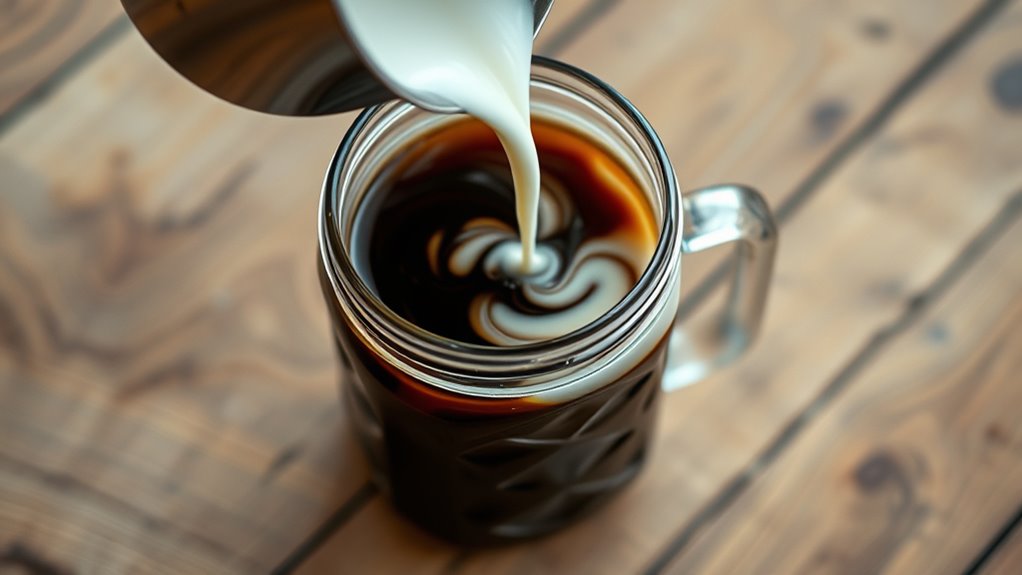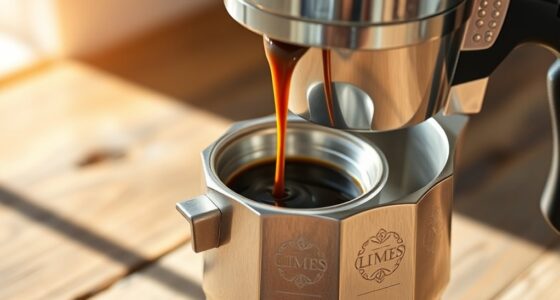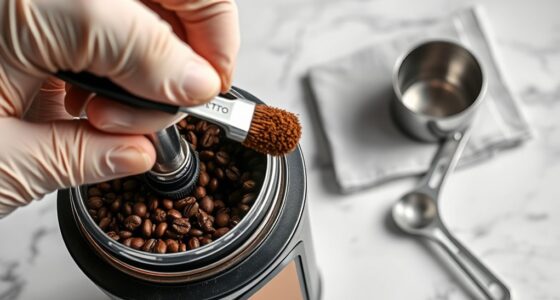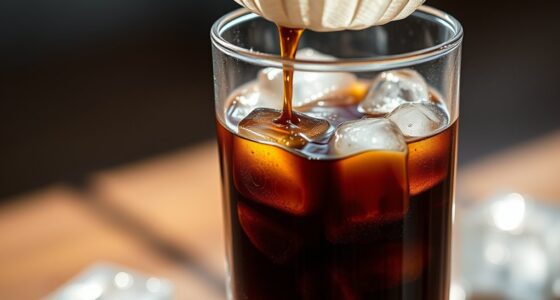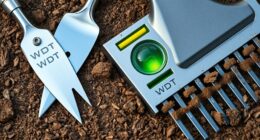Stop relying only on store-bought cold brew, and instead, start brewing your own for more control over flavor and strength. Use the right grind size and steep for 12-24 hours to avoid bitterness and guarantee smoothness. Store your cold brew in airtight containers at the correct temperature, and adjust the water-to-coffee ratio for your preferred taste. Avoid adding too much sweetener, and serve at the right temperature for the best experience—exact tips are just ahead.
Key Takeaways
- Stop relying solely on store-bought cold brew; brew your own for better control over flavor and strength.
- Avoid over-fine grounds and over-steeping; use proper grind size and steep for 12-24 hours for optimal flavor.
- Store your cold brew in airtight containers at 36-40°F and serve at 45-50°F for maximum freshness.
- Adjust coffee-to-water ratios and dilution to customize strength and prevent bitterness or weak flavor.
- Minimize added sugars and ensure proper filtering to enhance natural flavors and achieve a smooth, clear cold brew.
Relying Solely on Store-Bought Cold Brew
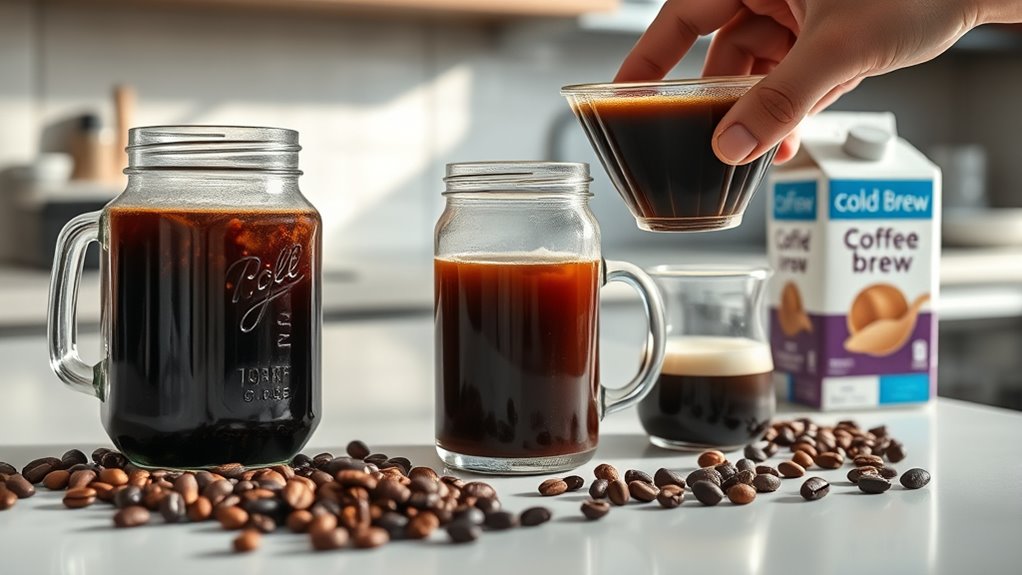
While store-bought cold brew can be convenient, relying solely on it limits your ability to customize flavor and strength. When you brew your own, you control the brew strength, making it as bold or smooth as you prefer. Achieving the perfect strength starts with consistent grind size; a uniform grind ensures even extraction and better flavor. If your grind is inconsistent, some coffee particles will be over-extracted, resulting in bitterness, while others remain under-extracted, dulling the flavor. By grinding your beans to an even consistency, you optimize extraction and create a richer, more balanced cold brew. Relying only on pre-made versions prevents you from tailoring your brew to your taste, so experimenting with grind consistency and brew strength makes your coffee more satisfying. Additionally, understanding lifestyle choices such as customized routines can help you develop a brewing process that fits into your daily habits.
Using Fine Ground Coffee for Brewing
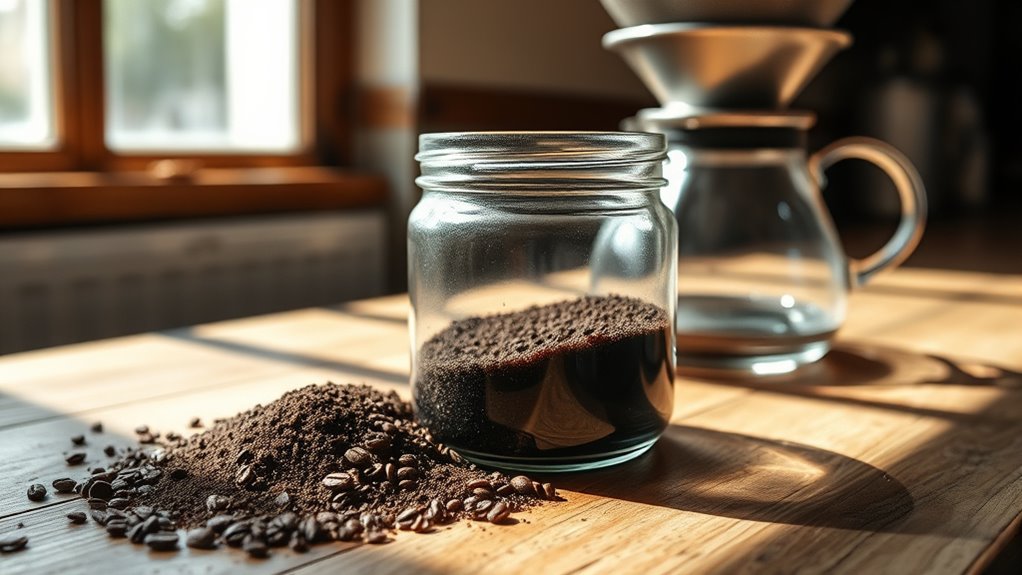
Using fine ground coffee can improve your extraction, giving you a richer flavor in less time. It also speeds up the brewing process, so you get your cold brew faster. Plus, it helps reduce sediment build-up, making your drink smoother and cleaner. Additionally, selecting the right grind size ensures optimal filtering efficiency and minimizes clogging during brewing.
Better Extraction Results
For better extraction results, selecting a fine grind for your coffee can make a significant difference in flavor and strength. When you use a finer grind, the surface area increases, allowing more flavor compounds to be drawn out during brewing. This results in a richer, more balanced cold brew. Make sure your brewing equipment can handle the finer grounds without clogging or over-extraction, especially if you’re using a fine mesh or filter. If you prefer milk alternatives, a finer grind helps ensure a smooth, consistent taste when mixed. Keep in mind that too fine a grind can slow brewing or cause over-extraction, so adjust accordingly. Ultimately, experimenting with a fine grind improves flavor clarity and delivers a more satisfying cold brew experience. Additionally, using a cold brew method specifically designed for finer grounds can help maximize extraction efficiency.
Faster Brewing Time
Opting for a finer grind not only enhances flavor but also speeds up the brewing process. When you use a smaller grind size, the surface area increases, allowing water to extract flavors more quickly. This means your brew time shortens without sacrificing richness. A finer grind allows the coffee to steep faster, so you can enjoy your cold brew sooner. Just be cautious—too fine a grind can lead to over-extraction or sediment in your drink. Adjusting your grind size appropriately balances speed and quality. If you need a quicker brew, switching to a finer grind is an effective trick. It reduces the overall brew time while still delivering a smooth, flavorful cold brew experience. Additionally, understanding how decluttering your space can help you organize your brewing setup ensures a more efficient and enjoyable process.
Reduced Sediment Build-up
When you brew cold coffee with a finer grind, you can substantially reduce sediment in your drink. Finer grounds produce a smoother brew with less sediment buildup, enhancing your drinking experience. To maximize brewing consistency and minimize sediment, consider these tips: 1. Use a high-quality, fine grind coffee designed for cold brew. This helps ensure even extraction and reduces loose particles. 2. Opt for a finer mesh or filter when pouring or filtering your cold brew. This catches smaller grounds and prevents them from reaching your glass. 3. Stir your mixture gently during brewing, avoiding agitation that can break up grounds and increase sediment. 4. Pay attention to the grain size of your coffee grounds, as the right size is crucial for achieving a clear, sediment-free brew.
Steeping Coffee for Too Long
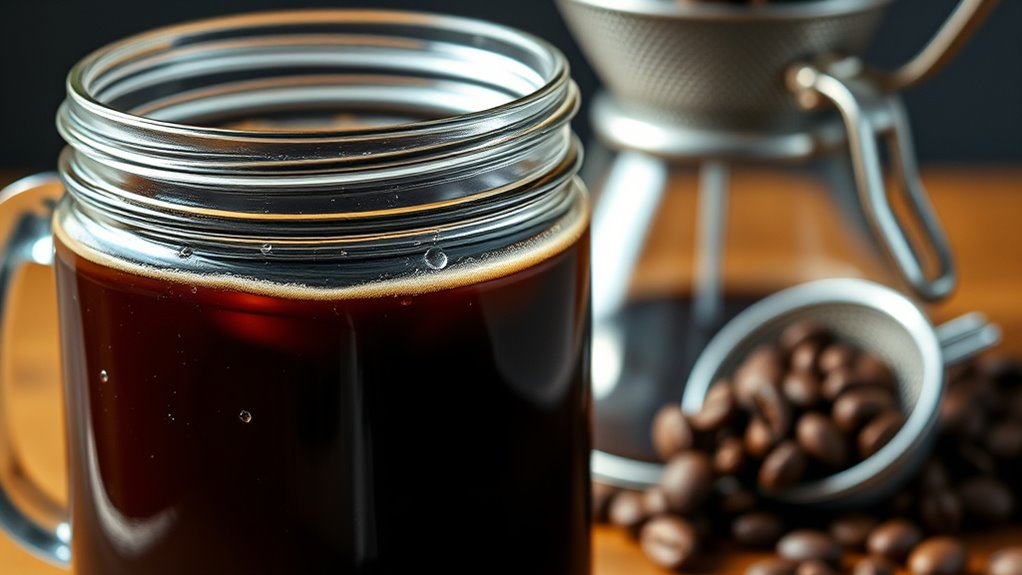
Steeping coffee for too long can lead to an overly bitter and astringent flavor that overwhelms the drink’s natural smoothness. When you over steep coffee, you risk flavor degradation, as excessive extraction pulls out undesirable compounds. This results in a harsh, unpleasant taste that masks the coffee’s nuanced notes. To avoid this, stick to recommended steeping times—usually around 12 to 24 hours—based on your preferred strength. Using a timer helps ensure you don’t accidentally over steep. Remember, longer isn’t always better; it often worsens the flavor. Keep an eye on your steeping process to maintain a balanced, smooth cold brew. Proper timing preserves the coffee’s rich, subtle flavors without the bitterness that comes from over steeping. Additionally, understanding the contrast ratio of your brewing method can help you better control the extraction process and achieve optimal flavor.
Storing Cold Brew in the Wrong Container

Have you ever stored cold brew in the wrong container and noticed it loses its fresh flavor? The key is using the right storage method.
- Always opt for airtight containers to keep out air and prevent oxidation that can spoil the flavor.
- Use refrigeration tips like keeping the cold brew at a consistent temperature, ideally between 36-40°F, to maintain freshness.
- Avoid glass or open containers that aren’t sealed, as they expose your cold brew to air and odors, diminishing quality over time.
- Incorporating proper storage techniques can significantly extend the shelf life and preserve the flavor of your cold brew.
Adding Excessive Sweeteners and Flavored Syrups
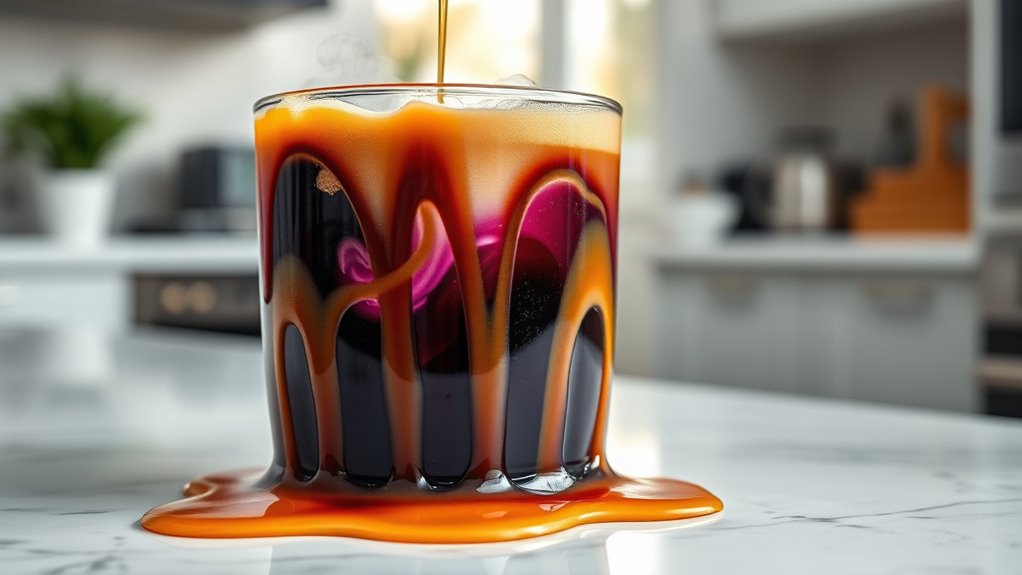
Adding too many sweeteners and flavored syrups can quickly spoil the natural taste of your cold brew. Instead of overloading with sugar or syrup, try sweetener alternatives like honey, agave nectar, or stevia. These options provide flavor infusion without overpowering the coffee’s rich profile. By using minimal sweetener, you preserve the coffee’s nuanced notes and avoid masking its natural qualities. Experiment with small amounts until you find the right balance that enhances, rather than masks, the cold brew’s flavor. Remember, subtlety is key—less is more when it comes to sweeteners. Incorporating flavor profiles can help you customize your cold brew to suit your taste without overwhelming its core aroma and taste. This approach allows you to enjoy a more authentic, flavorful cold brew experience without the sugar crash or artificial aftertaste that heavy syrups can cause.
Using Hot Water to Dilute Cold Brew
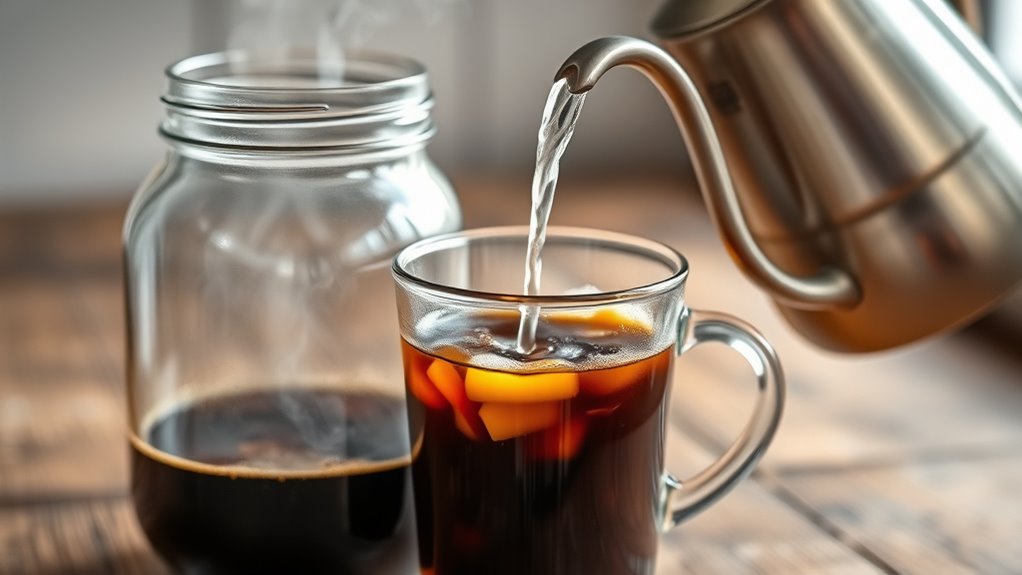
When your cold brew is too strong or concentrated, using hot water to dilute it is an effective way to adjust the flavor and strength. Hot water helps you control the dilution with precision, ensuring a balanced taste. Here are some simple dilution techniques to try:
Dilute strong cold brew with hot water for a smooth, balanced flavor.
- Start by adding a small splash of hot water, stirring gently, then taste-test before adding more.
- Use a thermometer to ensure the hot water isn’t too hot, which can alter the coffee’s flavor.
- For a smoother experience, combine hot water with ice after dilution, creating a revitalizing cold beverage without sacrificing flavor.
- As with family photoshoot fails, sometimes small adjustments can lead to unexpectedly delightful results, so don’t hesitate to experiment until you find your perfect balance.
This method allows you to customize your cold brew easily, avoiding overly intense or bitter flavors while maintaining the coffee’s richness.
Ignoring the Coffee-to-Water Ratio
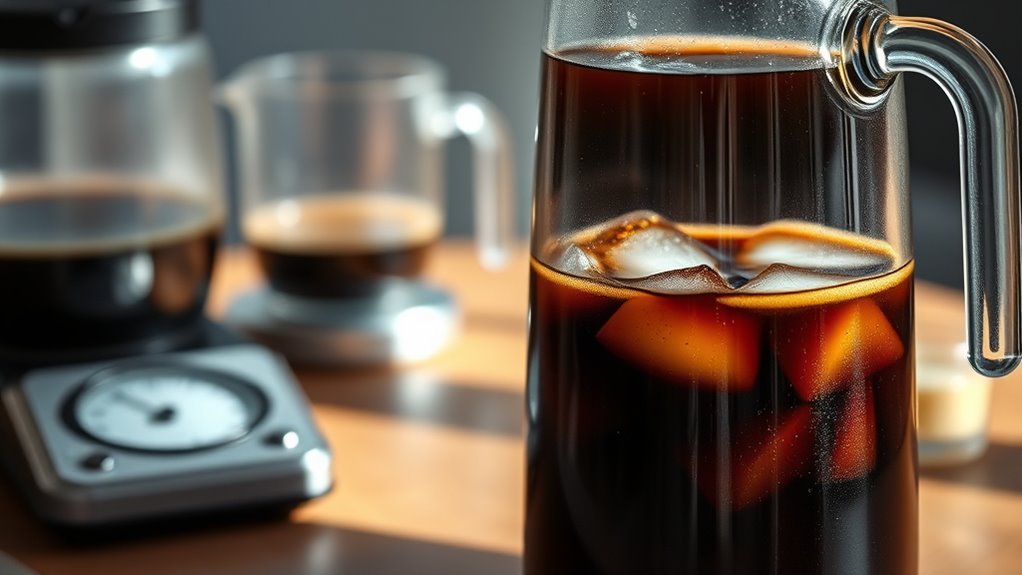
Ignoring the coffee-to-water ratio can lead to inconsistent and unbalanced cold brew. Without paying attention to the right ratio, your brewing strength may become too weak or overly strong, affecting flavor and potency. A proper coffee to water ratio guarantees you achieve the desired intensity and smoothness. Too much coffee makes the brew bitter and overwhelming, while too little results in a weak, underwhelming taste. To get it right, stick to a standard ratio—usually around 1:4 or 1:5 coffee to water—and adjust based on your preference. This simple step gives you control over your cold brew’s strength, ensuring a consistent, flavorful cup every time. Remember, precise ratios help you craft a balanced cold brew tailored to your taste. Additionally, using the right equipment, such as a gravel bike for smooth riding, can enhance your overall brewing experience by allowing you to explore different methods and settings.
Forgetting to Filter Before Drinking
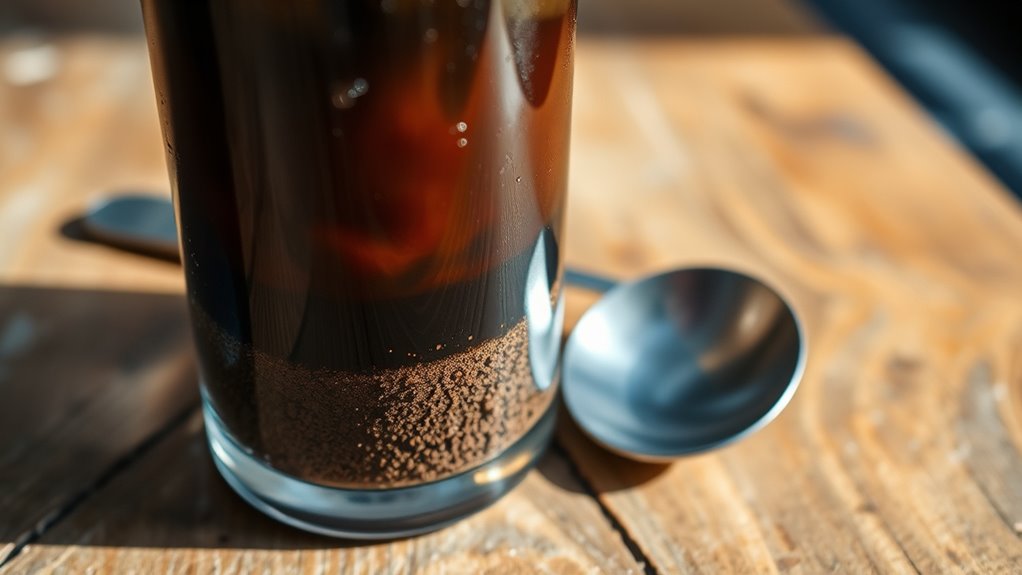
Skipping the filtering step before drinking can result in a gritty, cloudy cold brew that’s unpleasant to sip. Without proper sediment removal, you risk ingesting coffee grounds and debris that settle at the bottom. To improve your cold brew experience, focus on these steps:
- Use a fine mesh or paper filter during the filtering process to catch small particles.
- Pour your cold brew slowly to avoid disturbing settled grounds.
- Store your cold brew in a container with a tight seal, and give it a gentle stir before serving to ensure even sediment distribution.
- Incorporate proper filtration techniques to ensure clarity and a smooth drinking experience.
Serving Cold Brew at the Wrong Temperature

Serving cold brew at the right temperature is key to enjoying its best flavor. If you heat it too much or serve it too cold, you risk losing its smoothness and aroma. Proper storage and temperature control help you get the most out of your cold brew every time. Incorporating temperature regulation techniques can further enhance the beverage’s taste and freshness.
Ideal Serving Temperature
Serving cold brew at the right temperature is essential to enjoying its full flavor and smoothness. The ideal serving temperature enhances flavor and guarantees a refreshing experience. To achieve this, focus on proper temperature regulation.
Here are three tips:
- Serve cold brew between 45°F and 50°F for maximum flavor enhancement.
- Avoid serving it too cold, which can mute flavors and dull the palate.
- Use a chilled glass or add ice gradually to maintain consistent temperature without watering down the brew.
- Monitoring the serving temperature regularly ensures you enjoy the brew at its optimal flavor profile.
Maintaining the correct temperature reveals the rich, nuanced notes of your cold brew, making each sip more enjoyable. Proper temperature control is key to savoring the full depth of your brew’s flavor profile and guaranteeing a smooth, satisfying experience.
Avoid Overheating Cold Brew
Heating cold brew beyond its ideal temperature can quickly diminish its delicate flavors and smooth texture. Overheating can also cause the coffee to taste burnt or flat, masking the coffee bean freshness that makes cold brew special. To avoid this, don’t use traditional brewing equipment that’s meant for hot coffee, like stovetop pots or microwaves. Instead, serve cold brew straight from the fridge or add ice if you want it colder. If you prefer warmed-up coffee, gently reheat it on low heat, but never let it reach boiling. This preserves the nuanced flavors and prevents bitterness. Always pay attention to temperature, because even slight overheating can ruin the smooth, rich profile you’ve worked so hard to develop. Proper temperature control is essential to maintain the flavor quality of your cold brew.
Proper Storage Practices
Storing cold brew at the right temperature guarantees you enjoy its full flavor and smooth texture when you’re ready to drink it. Proper storage helps maintain coffee freshness and prevents spoilage. Use airtight storage containers to keep out light and air, which can degrade quality. Keep your cold brew in the refrigerator at about 37-40°F to preserve its flavor without freezing it. Avoid leaving it out at room temperature for extended periods, as this can cause bacteria growth and taste changes. Additionally, understanding the importance of proper storage can help you maximize the lifespan and quality of your cold brew.
Neglecting to Experiment With Different Coffee Beans
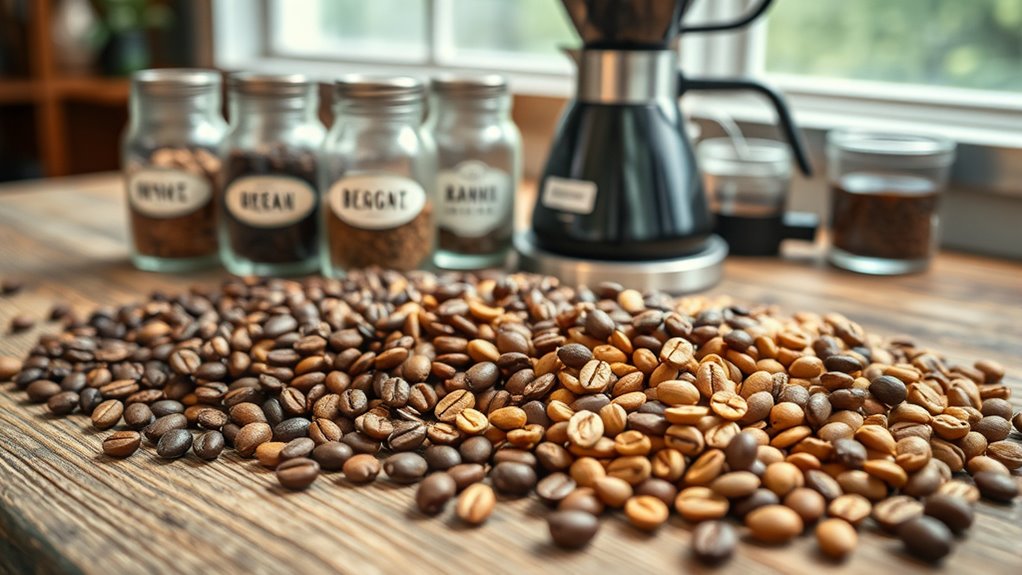
Many cold brew enthusiasts stick with the same coffee beans out of habit, but this limits your flavor potential. Sticking to one coffee bean variety means missing out on new tastes and aromatic profiles. Instead, you should actively pursue flavor experimentation by trying different beans—single-origin, blends, light or dark roasts. Each variety offers unique characteristics that can transform your cold brew experience. Experimenting allows you to discover which flavors you enjoy most, whether it’s fruity, nutty, or chocolatey notes. Don’t settle for routine; explore different coffee beans to keep your cold brew exciting and customized to your palate. Embracing variety enhances your brewing skills and guarantees you don’t miss out on discovering your perfect cup. Understanding coffee bean varieties can help you make more informed choices and elevate your cold brew game.
Frequently Asked Questions
Can I Make Cold Brew Without Any Special Equipment?
Yes, you can make DIY brewing cold brew without any special equipment. Simply coarsely grind your coffee beans, then mix them with cold water in a jar or pitcher. Let it steep in the fridge for 12-24 hours, stirring occasionally. Strain the mixture through a fine mesh or cheesecloth to remove the grounds. This equipment-free method lets you enjoy smooth, homemade cold brew without investing in a dedicated coffee maker.
How Long Does Homemade Cold Brew Last in the Fridge?
Homemade cold brew lasts about 10 to 14 days in your fridge, maintaining its flavor and vitality. To preserve its quality, store it in a sealed container, keep it away from light, and avoid frequent temperature changes. Proper storage duration ensures you enjoy the rich, smooth taste without compromising freshness. By following these tips, you maximize the cold brew’s shelf life and enjoy a revitalizing drink anytime.
What’s the Best Type of Coffee Beans for Cold Brew?
The best coffee bean varieties for cold brew are medium to dark roasts because they bring out rich, smooth flavors. Look for beans labeled for cold brew or espresso, as these often have a bolder profile. Medium roasts offer balanced acidity and sweetness, while dark roasts provide a robust, full-bodied taste. Avoid light roasts, which can be too bright or acidic, and opt for freshly ground beans for supreme flavor.
Should I Shake or Stir My Cold Brew Before Serving?
Think of your cold brew as a delicate symphony; you want each note to blend perfectly. When it’s time to serve, stir gently rather than shake. Stirring ensures a smooth, even mix, while shaking can cause unwanted froth and cloudiness. Use gentle mixing techniques to maintain the rich flavor and clarity. So, opt for stirring—your cold brew will thank you with a balanced, refined taste.
Is It Necessary to Add Milk or Creamer to Cold Brew?
You don’t have to add milk or creamer to cold brew if you prefer it black, but adding milk alternatives can enhance flavor and create a creamier texture. Whether you choose almond, oat, or soy milk, it’s a simple way to customize your drink. Experiment with different options to find what best complements your cold brew, making each sip more enjoyable and tailored to your taste.
Conclusion
Instead of sticking to the familiar, consider embracing these gentle shifts to elevate your cold brew experience. By refining your approach and exploring new possibilities, you might find a richer, more satisfying sip waiting just beneath the surface. Sometimes, the smallest adjustments open doors to unexpected delights. So, be open to change, and let your cold brew journey become a quiet adventure—one that rewards patience and curiosity alike.
